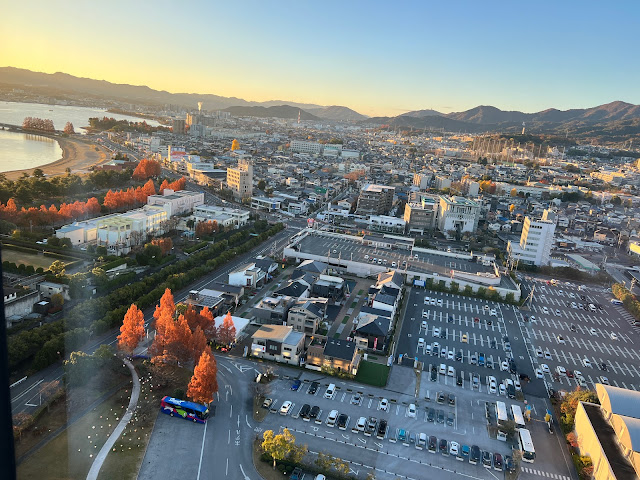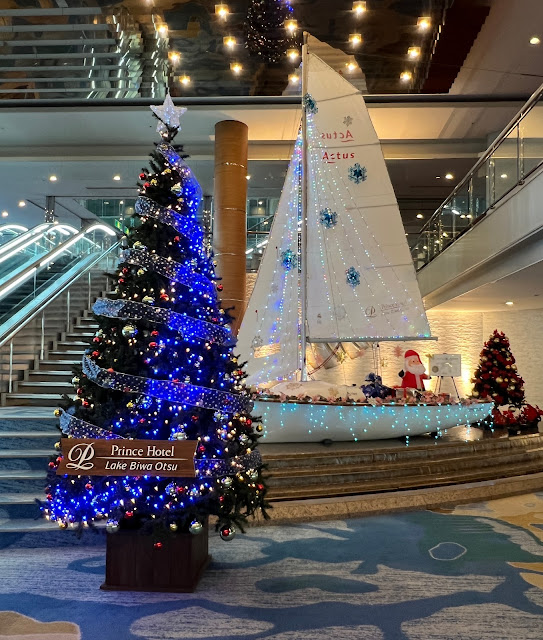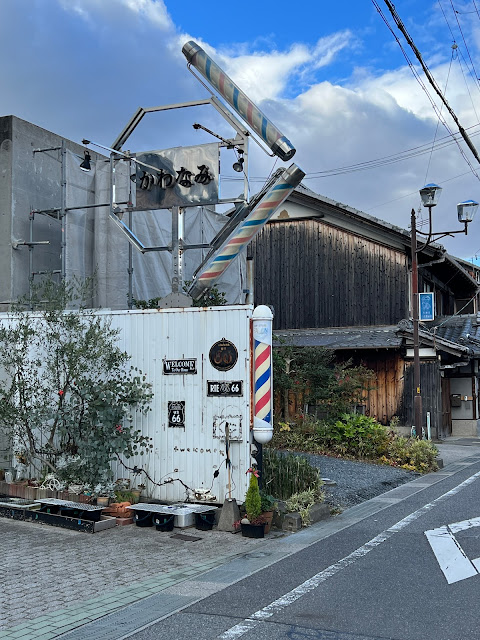As it had been dark when I checked into my up-market accommodation in Otsu, this morning was my first chance to appreciate a daylight view from the 25th floor. This is the lake-side vista…
…and this is the view over the city on the other side:
On the way out, I paused to enjoy the Christmas decorations in the cavernous lobby. I don’t think a yacht is Santa’s traditional mode of transport, but it makes sense given the hotel’s lakeside location, I suppose.
One of the bonuses that comes with the accommodation is a free shuttle bus to the town’s JR station, which is some distance away. From there a couple of trains took me to Kibukawa, and then a short bus ride to Minakuchi-Ishibashi.
The good thing about today’s walk was that very little of it was along Route 1. The bad news was that almost all of it was on narrow roads without a footpath, and plenty of traffic. It wasn’t a relaxing day.
Where the Tokaido passed through countryside, this was the typical scenery: small fields (well, small by Australian standards) and vegetable plots, many of them lying fallow for winter; scattered houses; hills in the distance. Here the Tokaido is in the valley of the Yasu River, as it was for much of the day.
Just before I briefly rejoined Route 1 and crossed the river, there was a reconstruction of an ichirizuka.
And opposite that, a small park and sign marking the old crossing point of the river.
Nowadays, the crossing is made via a large and busy bridge a few hundred metres downstream, where the chilly wind seemed particularly icy.
At Yoshinaga, bizarrely, the road passes under two small rivers, through narrow tunnels. Aqueducts, I suppose.
The green strip is supposed to represent the ‘safe’ route for pedestrians, and is common wherever roads lack proper footpaths. Here, I felt anything but safe as I hurried through the tunnel, particularly as the road takes a sharp bend to the left just beyond, and oncoming traffic would have little chance of seeing you. Obviously, I made it through unscathed.
At Ichibehigashi (East Ichibe), a beautiful shrine offered a chance to pay my respects for the day. After doing so, I sat and enjoyed the peaceful serenity of the setting, away from the bustle of the road.
Heading back down the steps towards the road, I noticed this line of … I’m not sure what to call them. Statues? Many are simply roughly-shaped stone, some with child-like or ghostly faces. They resemble jizo in many ways, but these I think are the first I’ve seen with white bibs rather than red, and they don’t have hats. Each image has a vase and a small bowl for offerings in front of it.
From the sublime to the ridiculous: they love a barber’s pole in Japan, and as every second or third business seems to be a hairdresser’s (I exaggerate, but there are a lot of them), you see plenty of the spinning helixes. I hadn’t seen this many outside a single shop, though.
Ichibe itself is station No.51 on the Tokaido (out of 53), a fact noted by these attractive signs. I liked the precision of the distance from Nihombashi: 457.5 km.
There’s also this large stone depiction of the entire route. Nihombashi is at the left and Kyoto at the right, for some reason, although north is up and south is down. Current location – Ichibe – is the station three from the right, picked out in white highlight.
On the outskirts of Kusatsu I spotted this uber-kitsch statue atop a hotel – a love hotel, presumably.
From the ridiculous to the sublime: just before reaching Kusatsu station, one last shrine for the day, this one beautifully maintained and obviously frequently visited.
From Kusatsu, a single train took me back to Otsu and the hotel’s shuttle bus. Although I hadn’t walked particularly far, and despite the route being almost perfectly flat, I was exhausted by the time I got back to my room. I think it was the stress of walking those narrow, footpath-less streets all day. I started to wonder whether I really would be able to get all the way from Kusatsu to Kyoto tomorrow.
















Comments
Post a Comment